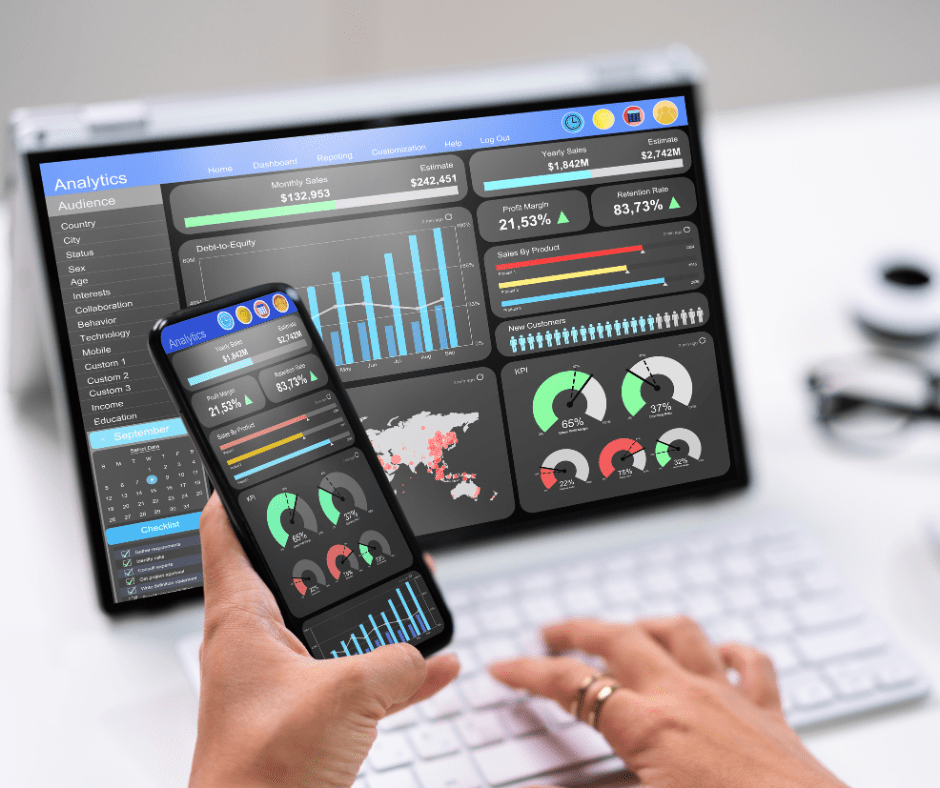What turns raw numbers into strategic business decisions? Data insights. These insights shape the path businesses take to grow, compete, and innovate. This article delves into how companies derive actionable knowledge from data, and use it to drive meaningful business outcomes.
Key Takeaways
Data insights are instrumental for businesses to make informed decisions by translating data into actionable intelligence, highlighting their importance in answering crucial questions and revealing hidden connections between data points.
Actionable insights are not just observational but include recommended actions and must be relevant, specific, and aligned with the company’s goals to effectively guide business decisions and strategies, as demonstrated in case studies like KFC’s ‘First Bite’ campaign.
Structured data serves as the foundation for business analytics, and systematic data integration into tools like data warehouses and lakes is critical for producing reliable insights. Effective data integration and a solid data strategy roadmap are key to navigating towards valuable insights.
Unveiling the Power of Data Insights
In the grand scheme of things, data insights act as the compass guiding businesses towards their goals. Data insights translate collected information into a deep understanding that assists businesses in decision-making processes. They serve as the key to solving complex business puzzles, providing valuable information that can help navigate the toughest business challenges.
Establishing data insights is like building a bridge between raw data and actionable decisions. This bridge is built through a meticulous analysis, where analytics serve as the framework for extracting insights from specified data. Imagine having a treasure map, but without the necessary tools to decipher it. The data is the map, and analytics are the tools that help us find the treasure – the actionable data insights.
The Essence of Data Insights

Data insights are the knowledge gained from analyzing data. These conclusions can benefit business operations at their core. But what exactly does this mean? Picture a jigsaw puzzle with numerous pieces scattered on a table. Each piece represents raw data – the unprocessed original facts and figures collected from various sources. At first glance, these pieces may seem unrelated and chaotic.
The magic of data insights comes into play when these pieces start to connect, forming a coherent picture. Key takeaways data insights bring coherence and relevance to this raw data, helping to answer key questions and uncover hidden connections. Just like completing a puzzle, insights provide clarity in making well-informed decisions.
By discovering patterns and relationships that were previously unknown, data insights offer a profound understanding of an organization’s information, leading to better decision-making and increased benefits for both the organization and its clients. To find data insights, it is essential to analyze and interpret the available data effectively.
From Information to Insight

The journey from raw data to actionable insights involves several stages:
Collection of data
Preparation
Analyze data
Interpretation
Each stage presents unique challenges and requires specific skills and tools. It’s akin to embarking on a mountaineering expedition.
To overcome these challenges, businesses can leverage modern analysis tools, such as data visualization and dashboards, augmented analytics with AI and machine learning, as well as embedded analytics. Just as mountaineers use advanced equipment to navigate treacherous terrains, these tools enhance the process of transforming raw data into actionable insights.
For instance, the value of a CRM can be greatly increased by enriching its database with additional data points, providing a deeper and more comprehensive understanding.
Crafting Actionable Data Insights
Data insights are not merely interesting facts or observations; they are actionable data insights that drive effective decision-making by indicating specific actions that businesses can take. Think of them as a compass, not just indicating the direction but also suggesting the path a business should take to reach its destination.
What sets actionable insights apart from other types of data analysis is that they explicitly include a recommended action to be taken. They are presented in a context that readily enables their leverage for driving key business decisions. These insights serve as a blueprint for creating consumer value and increasing business efficiency.
So, the next time you come across a data insight, ask yourself, “How can this insight be translated into an action that will benefit my business?”
Characteristics of Actionable Insights
To unlock the true potential of actionable insights, it’s crucial to understand their key characteristics. At their core, actionable insights must be:
Relevant
Specific
Clear
Aligned with the company’s goals, including Key Performance Indicators
This ensures that they add value in addressing company objectives.
An actionable insight is like a well-crafted guidebook for a traveler. It must be easily understandable, with specific plans for creating value in specified conditions. Just as a traveler relies on the accuracy of a guidebook to navigate a foreign city, the correctness of insights is crucial for reliable decision-making processes.
Moreover, just as a guidebook must be available when the traveler needs it, insights must be accessible to relevant individuals within an organization and delivered in a timely manner to reflect current realities and inform immediate decision-making.
Finally, insights gain actionability through contextualization, considering external factors and benchmarking against relevant standards, aiding in the understanding and reliability of the data.
Implementing Insights for Business Success

Actionable insights act as a catalyst, triggering actions that can lead to business success. Businesses that leverage actionable data can:
Make more informed decisions
Innovate in product development
Devise effective marketing strategies
Identify customer needs
It’s like having a master key that opens the doors to various opportunities.
To illustrate this, let’s consider the case of KFC’s ‘First Bite’ campaign. By effectively utilizing customer insights, KFC fostered a positive emotional engagement with their audience, demonstrating the value of customer experience focus. The impact? An actionable data culture that empowered the business to operate more effectively and gain insightful intelligence on customer behavior, providing a significant competitive advantage. This example proves that the right application of data insights can indeed set the stage for business success.
Data Collection and Integration: The Foundation of Insights
The magic of data insights begins with structured data. Just as a skyscraper needs a solid foundation, structured data forms the foundation for essential business frameworks such as data warehouses, data lakes, and various applications, unlocking significant business value when aptly integrated into data models.
However, the journey to valuable insights is not always smooth. Inaccurate or disorganized data, along with not having sufficient data and the possibility of human error, can lead to unreliable data insights, undermining decision-making processes.
To address these challenges, businesses undertake the process of data integration, which encompasses activities such as data replication, ingestion, and transformation. This process is essential for amalgamating different data types into coherent, standardized formats ready for analysis.
Systematic Data Architecture

Data, like the pieces of a puzzle, needs to be organized in a systematic way to make sense. A structured data architecture is essential for efficient data collection, storage, and accessibility, serving as the backbone of a company’s data management system.
This systematic data architecture ensures consistent data types across a dataset, leading to efficient storage and processing of data. The consistency in data types provided by a structured data architecture allows for easy querying using standardized languages such as SQL and enhances data accessibility. This is akin to organizing the pieces of a puzzle based on their shapes and colors, making it easier to put them together and see the bigger picture.
Streamlining Data Integration

Effective data integration is like a well-orchestrated symphony. To achieve it, it is essential to:
Establish clear objectives
Identify the necessary data sources
Reduce complexities
Define data communication methods.
Data warehouses, data lakes, and lakehouses are examples of structured data architectures that streamline integration by providing a centralized location for disparate data sources. The use of appropriate technology plays a pivotal role in enabling:
Accessible data visualization
Effective management
Operational efficiency
Risk management
Through effective integration, businesses can ensure their data sings in harmony, leading to valuable insights and informed decisions.
Analyzing Data for Deeper Understanding
The art of data analytics is like peeling an onion. There are multiple layers of information, each requiring a different approach to reveal its essence. Businesses use four core types of data analytics:
Descriptive analytics
Diagnostic analytics
Predictive analytics
Prescriptive analytics
Each type offers its unique perspective.
Descriptive analytics studies historical data to determine main features of a dataset, while diagnostic analytics delve deeper into data to understand why certain trends or events occurred. Predictive analytics focuses on analyzing data and statistical models to anticipate future outcomes, while prescriptive analytics predicts future trends and suggests actions. Each type of analytics adds a layer of understanding to the data, creating a comprehensive picture that fuels insightful decisions.
Diving into Data Analytics

The depth of data analytics is profound, offering a spectrum of approaches for analyzing datasets. Descriptive analytics interprets historical data to understand changes over time, whereas predictive analytics uses historical data to make projections about future outcomes.
Relational database management systems such as SQLite, MySQL, and PostgreSQL are pivotal for managing structured data which supports the complex analysis necessary for generating business intelligence. For insights to be truly actionable, they must be accurate, accessible to those who need them, timely, and comprehensible.
Leveraging Business Intelligence Tools

In the world of data analytics, visualization and business intelligence tools are the shining stars. They enhance data analysis and communication of insights, much like a telescope that allows us to see distant galaxies. With web analytics, you can further improve your understanding of user behavior and optimize your online presence.
Visualization tools are key for intuitively displaying statistical and complex data, enhancing the understanding and accessibility of information for informed decision-making. Technological tools such as Tableau and Power BI excel in data analysis and visualization, offering features for creating insightful dashboards and reports.
Furthermore, data storytelling is instrumental for effective communication of insights to leadership, leading to better buy-in for data-driven business initiatives.
Navigating the Path to Valuable Insights
Imagine setting out on a journey without a map. You may wander aimlessly, unsure of your destination or the path to reach there. Similarly, a data strategy roadmap is crucial to:
Clearly define objectives and goals
Understand the current data landscape
Prioritize initiatives
Allocate resources
Monitor performance
Utilizing data mining techniques will help drive successful data insight discovery.
A well-constructed roadmap is like a compass, guiding businesses towards their destination. Data strategy roadmaps facilitate:
Alignment of data management with business objectives
Improved decision-making
Increased efficiency
Competitive advantage
Assistance in compliance
Performance monitoring
Regular reviews and updates to a data strategy roadmap ensure it continues to align with evolving business objectives and adapts to changes in the data landscape or emerging technologies.
Defining Objectives for Insight Discovery

The first step in any journey is setting the destination. Similarly, setting specific business objectives is the initial step in creating a data strategy roadmap. These objectives guide the efforts towards uncovering insights that align with the organization’s strategic goals.
Defining objectives in the data insights process is initiated by stakeholders and aligns with the company goals, ensuring the insights match the business strategy and key performance indicators. By clearly defining the objectives, businesses can ensure their data analytics efforts are channeled in the right direction, leading to valuable and actionable insights.
Cultivating a Data-Literate Team
While data is the fuel, people are the engine that drives data insights. Developing a data-literate team involves not just training existing employees to adopt a data-informed mindset but also recruiting individuals who already possess these valuable data competencies. Data literacy includes the competencies to read, work with, analyze, and argue with data, skills which are integral to making expert, data-informed decisions across different business areas.
To cultivate a data-literate team, organizations should:
Identify suitable instructors for data literacy
Determine which departments require development
Decide if formal or informal training methodologies should be implemented
This ensures a well-equipped team, ready to navigate the data landscape and unlock valuable insights.
Case Studies: Transformative Data Insight Applications
Now, let’s bring the power of data insights to life through real-world case studies. These stories demonstrate how businesses have harnessed data insights to drive growth and innovation. From optimizing retail operations to enhancing customer bases through targeted campaigns, these cases showcase the transformative power of data insights.
The UK’s Automobile Association applied consumer insights to shift their branding from a rational, efficiency-focused message to an emotional one about the joy of motoring, generating stable revenue growth and yielding a profit of £2.23 for each £1 invested. Similarly, The Big Issue capitalized on the insight that coffee is purchased more frequently than magazines to boost sales and revenue by promoting their Change Please coffee, contributing to a 5% year-over-year increase in sales and a £1m revenue increase.
Retail Optimization Through Insights

Consider a retail chain that discovered that sales are consistently lower in certain regions during periods of extreme weather conditions. Customers tend to avoid visiting physical stores during such conditions, correlating to lower sales figures.
To address this issue, the retail chain implemented business strategies that are more weather-resilient. This is a perfect example of how analyzing sales data to identify trends can lead to the implementation of strategies that optimize retail operations and boost sales.
Enhancing Customer Base via Targeted Campaigns

Let’s look at another example where a company used insights to enhance their customer base. By analyzing customer purchasing patterns, the company developed personalized marketing campaigns.
Data on customer preferences and behaviors was extracted from the company’s CRM system, merging it with external demographic data. Segmentation techniques were then applied to this combined dataset to identify specific target customer groups. As a result, the email campaigns tailored to these segments led to a 20% higher open rate compared to non-segmented campaigns and a 15% increase in conversion among new customers.
This case study exemplifies how targeted campaigns, powered by data insights, can lead to an enhanced customer base and increased sales.
Summary
In conclusion, data insights hold the key to unlocking business growth. They transform raw data into valuable information, guide decision-making, and drive innovation. Whether it’s optimizing retail operations or enhancing customer bases, the power of data insights is undeniable. As we continue to navigate the digital age, the ability to harness these insights will become increasingly essential. So, are you ready to unlock the power of your data? If you want to learn more, you can Enrol in Off-Grid Singapore data analytics course titled “Excel Power Analytics: Mastering Data Insights“.
Frequently Asked Questions
What are data insights?
Data insights are valuable knowledge obtained from data analysis, helping businesses make informed decisions and drive growth.
What is the role of data analytics in generating insights?
Data analytics plays a crucial role in businesses by studying historical data, predicting future outcomes, and uncovering valuable insights from data.
How do actionable insights differ from other types of data insights?
Actionable insights stand out because they offer clear, specific, and relevant recommendations for action in a business context, enabling key decision-making. This sets them apart from other types of data insights.
What is the importance of a data strategy roadmap?
A data strategy roadmap is important as it helps businesses define data objectives, understand the data landscape, prioritize initiatives, and monitor performance, guiding their efforts towards successful data insight discovery.
How can data insights transform businesses?
Data insights can transform businesses by enabling informed decision-making, innovative product development, effective marketing strategies, and identification of customer needs, leading to business success. Various case studies demonstrate the positive impact of data insights.




